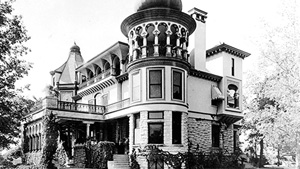
From Proud Heritage, Volume I by DCPA, not currently in print.
Obadiah Woodson Knight, a 38 year old Virginian, followed his older brother, Gabriel B., from Tennessee to Texas in 1846. Obadiah brought with him his 24 year old second wife, Serena Caroline Hughes, and seven children – five by his first and late wife, Mary Ann, and two by Serena. Obadiah and Serena produced nine more in the years that followed. Serena was one of the six “Hughes girls”, who, with their husbands, moved to Dallas County from the east. All families became prominent components of the community and their many descendants remain so today.
Obadiah gave the land, 3 acres, for the first log school house. His oxen teams hauled timbers from East Texas, and, along with $300 of his own personal funds, a magnanimous sum in that day, helped to construct Cedar Springs Institute. This was in 1859 and a fee was charged for each specific course. It wasn’t until the 1870s that free public schooling became available. Today’s Obadiah W. Knight School was built in 1925 honoring the generosity of the pioneer civic leader.The two most prominent sons of Obadiah and Serena were Robert E. Lee and Epps Gabriel.Robert E. Lee Knight became a leading lawyer and judge in Dallas County. He married Annie Armstrong and they had four boys and one girl, each of whom became a distinguished professional in his own field. The one daughter, Mary Watts, married Dr. Charles Flynn.Epps married Fannie Louise Patton, a wealthy beauty who fell in love with the tall, swaggering cowboy-farmer. It was with and through Fannie’s largesse that Epps established his broad and sweeping reputation of church and civic generosity over the years. He was a Democrat, a politician, Chief of Police, Tax Collector, and frequent speculator in real estate and oil leases. His Pied-Piper-of-Hamlin-esque qualities kept him in the limelight in the areas of “causes”, such as prohibition, politics his way, “bagging” criminals, and public awareness of his most and least civic involvement. His silver-tongued oratory mesmerized many followers for whatever the mission of the moment. He occupied the “Amen” pew of Oak Lawn Methodist Church for over forty years; he was a charter member of the Dallas Athletic Club; he served on many boards, especially, of Methodist organizations; he promoted the State Fair of Texas and helpedin the founding of Methodist, Baylor, and St. Paul’s Hospitals. He held the office of President of the Dallas County Pioneer Association for almost a quarter of a century. Epps projected a highly visible and vocal image before the citizens of Dallas County until his death in 1943, at the age of 85.
Fannie and Epps Knight were the parents of ten children. One died in infancy and asecond died at an early age, but the remaining eight lived long and full lives. Only the youngest, Hattie Mae, survives at this writing, December 1985. Today, there are 22 grandchildren and 17 great-grandchildren, but, ironically, not one to carry the name of Knight for the particular branch of the family. The single male Knight child, George Stuart Knight, Jr., died in infancy.
The last real estate holding of these survivors of Fannie and Epps is the ground where the Republic Bank stands in downtown Dallas. The family home on Cedar Springs was sold and demolished many years ago and all other holdings have since been liquidated.
By Serena Knight Corneliussen, Mesquite


